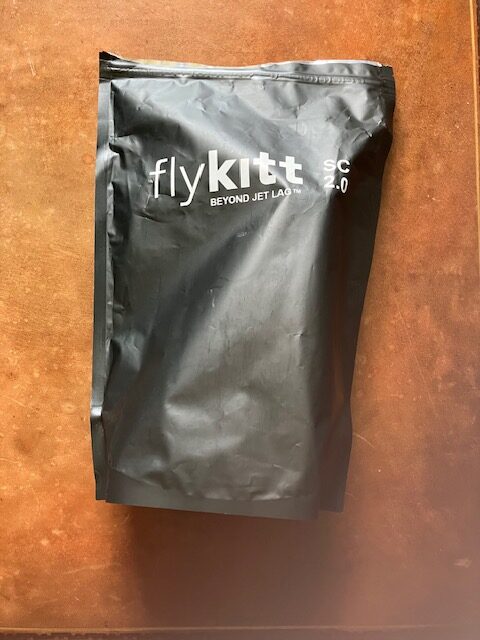Anyone who travels internationally has experienced jet lag and knows how it can mess up the first days of your trip, as well as your return home. There are plenty of jet lag remedies and tips on how to get over jet lag, but what if you could prevent it from happening in the first place?
On my recent trip to Australia and New Zealand from the U.S., I tried to do just that—and I succeeded. How? Read on and I’ll tell you all about how to avoid jet lag.
How to Get Over Jet Lag Quick Take
The best way to get over jet lag is to avoid it in the first place. A new product, FlyKitt, is one of the most effective ways to prevent jet lag that I have found.

What Is Jet Lag?
Jet lag occurs when you travel across multiple time zones quickly, as you do on an international flight. Your body clock, or circadian rhythm, is still on your home time and has difficulty changing to the new time.
It can cause you to feel excessively sleepy and groggy during the day, have trouble sleeping, experience decreased mental sharpness and physical performance, and have digestive issues. It can also depress your immune system, making you more likely to get sick. I tend to feel foggy, dizzy, and nauseated—almost like I’m seasick—as well as tired.
How long does it take to recover from jet lag? Symptoms can last from a couple of days to a few weeks, depending on the length and direction of your travel (traveling somewhere far away like Asia is tougher than the Caribbean, and going east is worse than going west) as well as physical factors.

How to Prevent Jet Lag
When you google “how to get over jet lag quickly,” you will find all sorts of articles giving a long list of tips. These include:
- adjusting your schedule to the time zone in your destination (by gradually shifting your sleep times in advance, which is hard to do; by not going to sleep if you arrive during the day; or by going right to sleep if you arrive during the night);
- regulating your exposure to sunlight and blue light;
- drinking plenty of water;
- eating light;
- limiting alcohol consumption;
- getting exercise;
- and using products like melatonin to help shift your body clock.
While these can be helpful in reducing the effects of jet lag, I’ve never found them to be completely effective. Even the best jet lag pills seemed to fall short. On a trip to Europe a few years ago, I tried them all but still felt tired and fuzzy for the first four days. This made it really hard to enjoy that time fully.

When you’re spending your precious vacation days and budget on an international trip, you don’t want to waste any of it feeling bad–especially if it’s a special occasion like your honeymoon! Instead of asking how do you get over jet lag fast, I wanted to know how to prevent jet lag in the first place.
A lot of products out there claim to help, but most of them aren’t that great. A new product, however, seems to have finally cracked the code on how to avoid jet lag. I tried it out on a recent long-distance trip from the U.S. to Australia and New Zealand and was very happy with the results.

FlyKitt: The Best Jet Lag Remedy I’ve Found
According to their website, FlyKitt prevents jet lag in 93 percent of their users, which include top athletes, business executives, and military special operations personnel. It definitely worked for me. One of the things that makes FlyKitt the best jet lag remedy, in my opinion, is the comprehensive approach it takes to beating jet lag.
FlyKitt’s creator looked at all the factors that go into jet lag and used research with fighter pilots and Navy SEALS—people who have to travel and then perform at high levels—to develop the patented system.

The unique multi-pronged approach utilizes an app in addition to dietary supplements and light-blocking glasses to adjust your circadian rhythm just before, during, and just after the flight so you can hit the ground running. You can learn all about the science behind FlyKitt’s approach in a white paper on their website.
In their research, they discovered that a major factor in jet lag is the inflammation that air travel causes. This was not something I’d read about in any of the “how to get over jet lag” articles; in fact, FlyKitt claims to have discovered this link. I think it’s the key to what makes FlyKitt so effective.

How to Avoid Jet Lag with FlyKitt
FlyKitt is both a physical product and an app. When you place your order, you’ll receive a sleek and small zippered bag with supplements, instant coffee and sugar packets, and light-blocking glasses. You can also add compression socks and a Firefly muscle stimulator to help increase circulation and reduce your risk of getting blood clots during long flights.
The supplements are divided into types labeled Gold, Red, Green, and Blue, each with a specific role to play in preventing jet lag. The Gold supplements contain fish oil, omega 3 fatty acids, and vitamin E. Green supplements have B vitamins, Red supplements have vitamin C and tart cherry powder, and Blue supplements have magnesium and melatonin.

All of the supplements are FDA cleared, made in the U.S., non-prescription, and NSF Certified for Sport for pro athletes. FlyKitt also offers vegan options. Note that they are formulated for ages 18 and up, however, so they’re not for use in children. Luckily, most kids don’t tend to suffer from jet lag.
One of the keys in preventing jet lag is regulating your exposure to light, and FlyKitt’s glasses block 99 percent of circadian light signals, which helps you sleep and improves the quality of your sleep.

The AI-assisted app is what makes FlyKitt so genius, in my opinion. Once you enter your trip itinerary, it creates a customized plan that is based on you and your usual sleep schedule.
The plan tells you when to eat, when to sleep, when to avoid light, and when to take the different supplements and use the caffeine and sugar to reset your circadian clock. It starts on the morning of your trip and continues for a day or two after you arrive.
If your itinerary changes or flights are delayed, you just go into the app and update the details and it will give you a new schedule.

It can be a little awkward to implement the plan, because since it’s trying to get your body shifted to your destination’s schedule you’ll be eating and sleeping at what feel like odd times. You’ll also be eating more frequently. I found it to be somewhat counter-intuitive, but I followed the instructions as closely as I could and was amazed at the results.
After both my flight to Australia and my return flight home from New Zealand, I didn’t experience any jet lag symptoms aside from being a little tired for the first couple of days. That didn’t affect my activities, however.
Upon arrival in Australia (at night), I was able to go to bed, sleep well, and get up when I wanted to the next morning. When I came home, I went to sleep easily, slept through the night, and woke up without too much effort at my usual time. These are pretty spectacular results, given the significant time difference between the U.S. and these countries, and the fact that I traveled over the international date line.

The FlyKitt website offers several different product levels. The starter bundle is $99 and includes 2 trip plans, 4 customized supplement packs, 1 pair of blue light filtering glasses, and the carry case.
Once you’ve bought the initial kit, you can get refills for other trips. Trip plans and supplements cost $69 per round-trip flight.
You can also add a Firefly Neuromuscular Stimulator and compression socks to boost the circulation in your legs, help reduce the risk of blood clots, and prevent muscle stiffness. This costs $47.
The FlyKitt app is free to download. It’s only available for iOS products; Android users can get their customized plans via email.
Now that you’ve read our recommendation for how to get over jet lag, what do you think? Will you give FlyKitt a try? Have you found other successful jet lag remedies? Let us know in the comments!
And if all this talk of international travel has you ready to plan a trip, feel free to reach out to one of our trusted travel advisors!
This article was written by HoneymoonAlways editor and writer Ashley Ellington Brown.
Ashley has always loved to explore new places and indulges her passion for travel whenever she can. She has been to 12 countries and 32 states so far.
Ashley has worked as a freelance writer for more than 20 years, specializing in the areas of travel, marketing, personal development, and the pursuit of happiness.
Favorite destinations include Sorrento and Capri, Italy; Haarlem, Netherlands; Paris; Sydney and K’gari, Australia; Rotorua and Waiheke Island, New Zealand; the American West; Palm Beach; the Florida Keys; and her hometown of New Orleans. Ashley has a goal of visiting every state plus many more international destinations.

